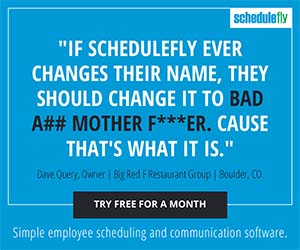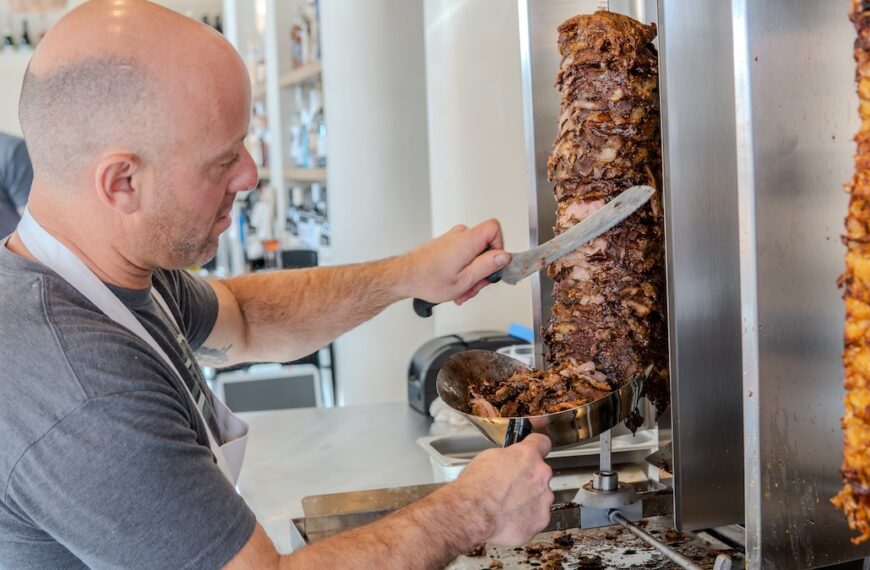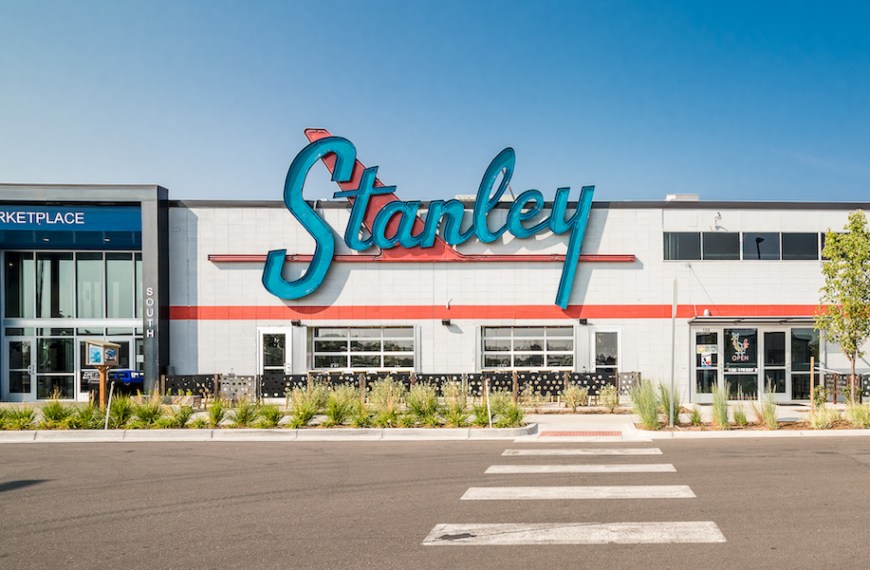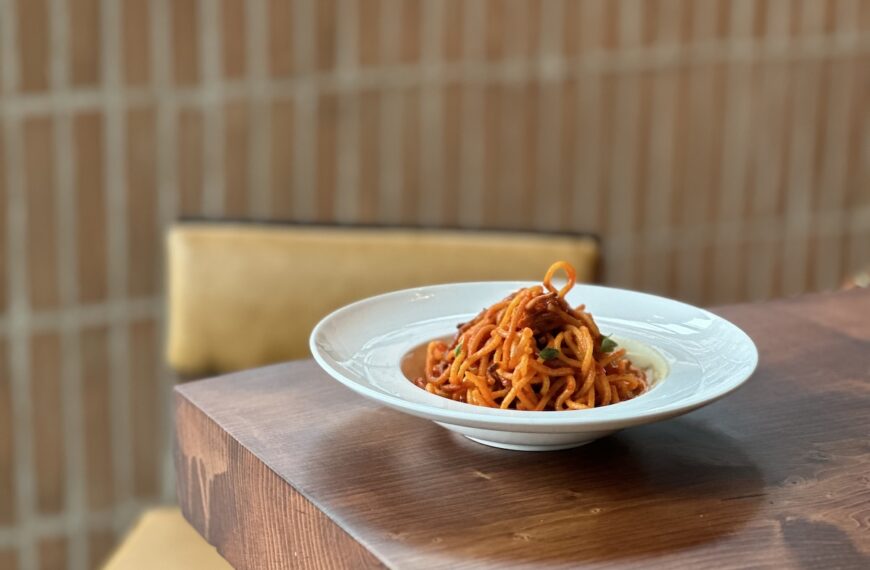
Split Shift
Joshua Pollack is back in the kitchen. For eight hours a day, six days a week, he makes bagels, like any hourly employee. It’s a big shift after five years of working mostly behind the scenes as founder and owner of Bridge & Tunnel Restaurant Group, which runs six Denver eateries, including Rosenberg’s Bagels & Delicatessen and Sherry’s Soda Shoppe. He’s still CEO, of course, so after his shift ends, Pollack heads to the office for another four hours of work before he closes his computer, turns off the light, and drives home to take care of the kids.
Because Pollack’s casual eateries were able to transition to pickup and delivery service fairly easily, staffing wasn’t a problem for the first year of the pandemic. “We actually had a great influx of amazing employees,” Pollack says. “Then when everyone started to reopen [this spring], that’s when it really fell out. It was like almost overnight, staffing became seemingly impossible.”
It’s a familiar scenario for business owners and managers this year as the lack of employees (and applicants) requires they roll up their sleeves and take a spot alongside their workers—on the floor waiting and bussing tables, on the line, and even at the sink—in order to keep their businesses afloat. Staffing shortages became so acute this summer that many restaurants were forced to cut hours and close on days they would normally be open. The labor shortage made headlines. But the lack of employees has created a slew of additional problems: callouts are rampant, service is declining, morale is low, and burnout is high. It’s easy to blame it all on COVID, but how many of these staffing challenges are really new? Or did COVID merely bring these issues to the forefront? Is there a lesson to glean from the madness?
“We’re not that big of a city right now to get those kids who want to be here for food. We have restaurants opening every three days. How do you think we’re going to staff it?“
Dave Hadley, Samosa Shop
“Staffing has always been difficult,” admits Rose Votta, general manager of Frasca Food and Wine in Boulder. Many business owners agree: While this is the worst it’s ever been, staffing was difficult before the pandemic, too. Veterans, like longtime chef Jamey Fader, now culinary director for Marczyk Fine Foods, remember 20 to 30 years ago, when there were more applicants than available positions in Denver’s restaurants. “When there were 20 restaurants and the city was burgeoning, you could pull from a pool filled with more fish,” he recalls. “We have had such incredible growth… in restaurants and hospitality as a whole. You end up having a diluted workforce.” Chef Dave Hadley agrees: “We’ve grown so fast… without the people that want to staff it.” Hadley moved to Denver almost a decade ago to pursue a career after graduating from the Culinary Institute of America. “We’re not that big of a city right now to get those kids who want to be here for food. We have restaurants opening every three days. How do you think we’re going to staff it?”
While it’s never been much of a problem to hire for the front of the house, Fader says it’s historically more difficult to staff the back. “[Being a cook] is not the highest-paying job out there. It’s hard work and very challenging conditions—it’s hot, you can burn yourself, you can cut yourself,” he says. “You’ve got to be very inspired and motivated and passionate to start that journey.”
Now 28, Hadley has built a résumé that includes time as sous-chef at the Preservery, chef at Acorn, and culinary director for Stone Soup Collective. Last year, Hadley opened his own concept, Samosa Shop, and he believes others like himself—young chefs who came into the kitchen with a love for food and hopes for culinary careers—have also left employers’ kitchens to pursue their individual culinary dreams, adding to the dearth of experienced kitchen staff. But Fader says that’s only part of the issue.
He believes the industry, which he refers to as “somewhat broken,” has come to a pivotal point: The long hours, low wages, lack of benefits, and challenging work conditions that were long considered the norm are no longer acceptable to many. If it was an undercurrent beforehand, the pandemic brought dissatisfaction to the forefront.
“With the pandemic, people are focusing more on work-life balance,” says Katy Foster, owner of Stir Cooking School, a recreational cooking school that offers group classes to the public. Part of that balance includes more attention to mental health and the realization that working crazy restaurant hours isn’t good for one’s mind or body. When John Hinman, owner of Hinman Pie and founder of Culinary Hospitality Outreach and Wellness (CHOW), began his culinary career more than two decades ago, he recounts, “There were three of us [in the kitchen], all under 25, with not much cooking experience. We did those 18-hour days because we didn’t know anything else. That’s how you were supposed to come up in the industry: Start as a dishwasher and get beaten to the top. I think that’s really changed.”
That desire for work-life balance, however, has exacerbated the staffing issue. Not only are there fewer job applicants, but if even dedicated employees don’t want to put in those long shifts and overtime, restaurants may need even more workers than before. “To avoid turnover, you really need good pay and flexible scheduling,” says Votta. “I think people in all industries want more time for their personal lives, people want more time for their families. Ultimately, it lies on the company to hire more people to get that work done. If you have a certain amount of work to do and you can’t do it with 20 people, you need 25 people.” Normally open six days a week, Frasca cut back to five days a week this year, despite a record-breaking season. Even then, by the end of September, Votta’s small team was still short a few people and working about five to 10 hours of overtime each week to compensate. “It’s something I try to avoid,” she admits. “My goal is to have enough people on the team to manage my labor appropriately, but when you lose people or the demand is so high and you don’t have enough people, it puts a strain on the team. That’s not sustainable.”
“I’ve always thought it was more important to hire off of passion and culture fit than anything else.“
Joshua Pollack, Bridge & Tunnel Restaurant Group
The scarcity of employees has created an applicant market ripe for unprofessional behavior. “It’s so wide open that if you feel like you’re being mistreated or it’s not your gig, you can just up and walk out that day and have another job by that afternoon,” Hinman says. Callouts and no-shows—already commonplace before COVID—have become more frequent. “We’ll have 32 people signed up for a group interview and two will show up,” Pollack explains. “We’ll hire one and they won’t show up the first day of work. We’ll go through five days of training and someone will no-call, no-show. Someone will put their shift up and if it doesn’t get covered, they just won’t come to work. Everyone’s late, people don’t wear uniforms. They don’t care, because they know they’re not replaceable.” Some business owners feel they’re up against the wall. They may have no choice but to take back an employee who defies policies or was a no-call, no-show the previous day, simply because there already aren’t enough bodies to staff the restaurant.
That may be a bleak outlook, but it’s not hopeless, Fader says. This difficult time provides businesses an opportunity to re-examine their operations, better understand their inefficiencies, and focus on their missions. “If you don’t like it, change it—and if you can’t change it, change your perspective,” he says. “We can keep banging our heads up against the wall, or we can say, ‘All right, we need to innovate.’” At Marczyk Fine Foods, a neighborhood grocery that offers homemade foods for breakfast, lunch, and dinner, that meant tightening the number of items it offered in order to lighten the load on its drivers, and culling its selection of entrées and ice cream flavors to increase production efficiency. It also meant better understanding the needs of its employees, and offering more flexibility to keep them content. That might mean cross-training those employees with an eye on management, but weekends off for the guy who works late as a DJ Friday and Saturday nights. “We truly want to be the best place to work—that’s one of our values and missions,” Fader says. “Being able to adapt… has created a lot less turnover for us. So, while it [may] be much harder to hire and recruit, we have had a lot less turnover the last 18 months.”
Foster also feels positive despite the struggles. She recently fired an employee for sexual harassment—something to which some employers might have been tempted to turn a blind eye, especially with the labor shortage—but Foster feels it’s more important than ever to show her team that though these things might have once been the norm, they will no longer be tolerated. “If, as an industry, we’re trying to do better, we can’t pick and choose what works for us,” she says.
“I think it’s open season in the restaurant industry right now for new people and new ideas,” Hinman says. “I think a lot of people might be getting into it who have been curious for a long time, but never took the leap. Now there’s an opportunity to get in on the ground floor again. Some restaurateurs are really taking a different stance on finding a livable wage, break time, and treating the cooks like humans.”
The current labor crunch aside, the mass exodus of longtime industry veterans might be a blessing in the long run. It’s a chance for fresh blood, so to speak. “You saw a lot of people who already knew everything and you couldn’t teach them anything,” Pollack says. Now that there are more inexperienced candidates than veterans, many employers are focusing on passion over experience in their hiring process. “I’ve always thought it was more important to hire off of passion and culture fit than anything else,” Pollack says. “We’ve been very successful with that. I want to come into one of my spaces and feel like everyone loves what they do.”
“I love the team we have now. We’ve put a team together that’s really excited about what [we do].“
Katy Foster, Stir Cooking School
“There are things you can teach and things you can’t,” Fader says. “I can teach you how to answer a phone, how to chop an onion, how to sear a scallop. I can’t teach you to care, to tell a joke, to have a sense of humor. Those are intangibles. Those are the things you bring with you at a DNA level, in my opinion, and I’d always rather hire for that.”
“The biggest thing [for me] is to be passionate about food and to want to learn,” agrees Foster, who has built an entirely new staff since the pandemic. While her last team was certainly hardworking, this one is much more cohesive and positive. “I love the team we have now. We’ve put a team together that’s really excited about what [we do]. I think having a new team and having to go through the difficulty of it makes you want to pick people who really want to be there.”
That may be the silver lining of this incredibly difficult time: more flexible, caring, and appreciative employers and more passionate, energetic, and enthusiastic employees for a more positive and healthy work environment and a more successful, resilient business. “I think there’s a different respect for each other now,” Hinman says. “It’s not about the food cost as much as it is the overall cost of the business, at this point.” As Hadley says, it might be difficult to find employees, but once you find the right ones, they’ll be in it for the long haul. “I think we’ll be able to look back on this period and say, ‘Wow, look what we’ve maintained and what we’ve achieved,’” Votta agrees.
Although making bagels eight hours a day, six days a week, may not have been part of Pollack’s vision several years ago as he moved into his role as CEO and focused his energy on expanding his restaurant group, Pollack says that working with customers again has been another positive during this challenging time as a restaurateur. “I’ll almost get into a mini-depression and then I’ll run into a customer that thanks me for everything we do,” he says. “I get to see and be reminded of the joy we bring to people through our food. That’s why we do what we do.”
Talk to us! Email your experiences (and thoughts, opinions, and questions—anything, really) to askus@diningout.com.












Comments are closed.